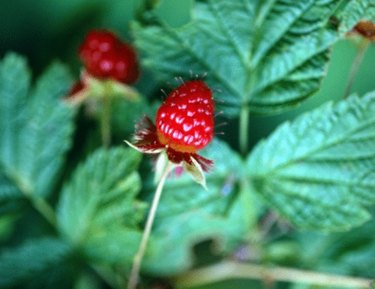
Raspberry plants begin bearing fruit the second year after planting. By the third year, the home gardener can usually look forward to a full crop. Cultivars exist offering fruit in shades of red, black, purple and yellow. The raspberry plant produces a perennial root system and canes with an average life span of 2 years. Floricane fruiting raspberry types bear fruit only on 2-year-old canes, but primocane fruiting types produce on both first and second year canes.
Reproduction
Video of the Day
The raspberry plant forms a dense thicket that reaches about 10 feet in height. It reproduces through extensive sucker growth from its root system. The plant also produces abundant seeds. The seeds remain in the ground until ideal climatic situations spur germination. The U.S. Forest Service states that the seeds have the capability of remaining viable for 60 to 100 years or more. The seeds' viability increases with age achieving maximum viability at 50 to 100 years old. Young seeds rarely germinate well. Mice, chipmunks and birds all aid in the seeds' dispersal.
Video of the Day
Life Cycle and Growth
Seedlings can quickly overwhelm a disturbed location. The plants grow best in full sunlight but can persist in areas with patchy light. The plants do not survive in areas with a dense tree canopy. Raspberry plants tolerate a diverse array of soil conditions but require adequate moisture. Most stands only live for 5 to 12 years before dying. During the plant's first year of life, it produces vegetative shoots. During the second year, the stems produce flowers and fruit. Second-year canes usually die during the winter months.
Flowering and Berry Production
During the winter months, the flower buds begin to develop. Low temperatures and short days help the plant begin to form the buds. Primocane-fruiting cultivars begin bud formation during the summer months. Once flowering occurs in either in the spring or summer months, the plant's fruits begin appearing. The flowers depend on bees, flies and beetles for germination. The fruits first develop at the canes' tips and work their way downward. The fruit does not particularly long on the stems before breaking down. Harvest raspberry fruits as soon as they are ripe. Once picked, the fruit usually lasts three to seven days if stored at 33 degrees.
Development Requirements
Raspberry seeds must undergo both a period of warm and cold stratification. The seeds require 90 days of temperatures that hover at 68 to 86 degrees. They also need a cold spell spanning a minimum of 90 days at 36 to 41 degrees. If the seeds only undergo a period of cold stratification, they will not germinate. Digestive enzymes within an animal facilitate and increase seed germination when the seed passes through the animal's digestive tract.
- U.S.Forest Service; Rubus idaeus; D. Tirmenstein; 1990
- Purdue University; Raspberries; Bruce Bordelon; December 2001
- University of Maine; Growing Raspberries and Blackberries; David T. Handley
- University of California; Caneberries; December 2009
- U.S. Department of Agriculture: Rubus Idaeus
- University of Illinois Extension: Planting Raspberries